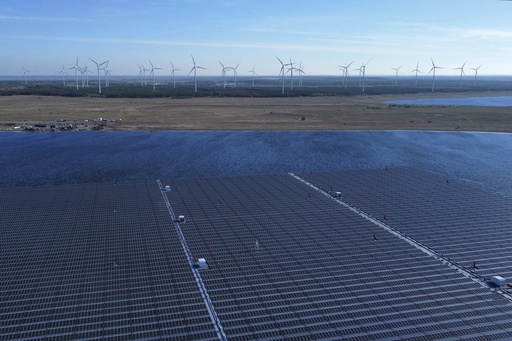BAKU, Azerbaijan — As the world experiences unprecedented heat waves this year, humans are emitting an additional 330 million tons of carbon dioxide due to fossil fuel combustion compared to last year.
This year, emissions are projected to reach 41.2 billion tons of carbon dioxide, marking a 0.8% increase from 2023, according to the Global Carbon Project, a collective of researchers monitoring global emissions.
Reports from various United Nations organizations indicate that global emissions must be reduced by 42% by 2030 in order to potentially limit temperature rise to an agreed 1.5 degrees Celsius threshold.
The rise in emissions for this year is less steep than the 1.4% increase noted in the previous year, as presented at the recent United Nations climate talks in Azerbaijan.
If current fossil fuel consumption trends persist, the planet is on course to exceed the 1.5 degrees Celsius limit, set during the 2015 Paris Agreement, in six years, according to Stephen Sitch, one of the co-authors of the study.
Currently, the world temperature stands at 1.3 degrees Celsius above pre-industrial levels, according to United Nations data.
“We clearly are not doing enough on a global scale to reduce emissions. It’s as simple as that,” stated Mike O’Sullivan, a climate scientist from the University of Exeter and another study co-author.
He emphasized the need for greater ambition and innovative solutions to curtail emissions, free from fossil fuel industry influence.
The researchers based their findings on reported emissions from affluent nations and data from the oil sector. The projections for 2024 account for data from the past couple of months.
The Global Carbon Project provided insights into emissions from the top four carbon-emitting regions: China, the United States, India, and Europe, while also offering detailed data for around 200 other countries for the year 2023.
The majority of the continued growth in carbon emissions is attributed to developing nations, with a significant contribution from China, which alone accounts for 32% of global emissions.
Contrary to expectations that China’s emissions would plateau, they actually increased by 0.2% this year, with coal emissions rising by 0.3%, according to estimates from the Global Carbon Project.
On the contrary, India’s emissions surged by 4.6%, cementing its position as the third-largest emitter, contributing 8% of the world’s carbon pollution.
Meanwhile, both the United States and the European Union saw reductions in carbon emissions, with a 0.6% decline in the U.S. attributed mainly to decreased reliance on coal, oil, and cement.
The U.S. accounted for 13% of global carbon emissions in 2024 but has historically contributed 21% since 1950, highlighting the long-lasting impact of these emissions.
O’Sullivan noted that 22 nations have consistently reduced emissions, including the United States, which has recorded the most significant declines between 2014 and 2023, alongside Japan, Germany, the United Kingdom, and Ukraine.
Europe saw a notable reduction of 3.8% in carbon emissions, largely due to substantial cuts in coal usage.
Overall, global carbon emissions have more than doubled compared to 50 years ago and increased by approximately 6% over the past decade, with total emissions rising 50% since 1999.
“This serves as a crucial reminder of the urgency needed to tackle the underlying causes of the climate crisis,” commented Mohamed Adow, founder of PowerShift Africa, who was not affiliated with the study.
He highlighted the resistance from the fossil fuel industry, which seeks to maintain its operations.
The ongoing combustion of coal, oil, and natural gas results in a staggering release of 2.6 million pounds of carbon dioxide every second.
Despite the troubling trends, overall carbon emissions, which encompass fossil fuel pollution and land use changes like deforestation, have stabilized due to a decrease in emissions from land-use activities.
This development is seen as a hopeful milestone amid adverse environmental news, as pointed out by Michael Mann, a climate scientist at the University of Pennsylvania.


